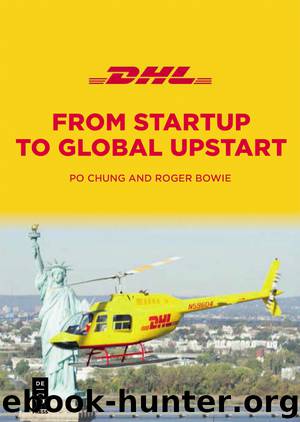DHL by Po Chung

Author:Po Chung
Language: eng
Format: epub
Publisher: De|G Press
Published: 2018-06-15T00:00:00+00:00
This Was an Outbound Phenomena
For the most part, however, this was an outbound service, in that it was originated by the sender, not the receiver. Certainly, this distinction is blurred when it comes to regular exchanges of pouches between multinationals on key routes, but what was more common in these types of exchanges was the fact that the service was for the most part originated by the company’s head office, and the branches would follow. As mentioned above, this outbound orientation mirrored the lack of maturity we would later see with the integration of supply chains to, from and between different players engaged in the supply, production and distribution of a given product. Logistics was still a new term, as was supply chain management, and the first signs of integration started with coordination of sourcing with distribution, while production remained an island of independence. But even here, the predominant purchasing behavior was for someone to send something through DHL, rather than ask for it to be collected somewhere else and received. Suppliers were more frequently asked to send something via DHL and pay for it themselves, in order to satisfy their own customer’s requirements.
In part, this was because DHL’s systems were set up for outbound service, which made it easier to organize a homogenous service among a network of “independents” and kept things to the “KISS” principle (Keep It Simple, Stupid). But it was also because, in the traditional world of freight forwarding, the opposite was more the rule, in that the country of origin and the country of destination had separate roles to play, one for export and one for import. Customs regulations were focused on the fact that the principal party to a transaction was invariably based in the home country, and thus the processes for export relied on the declaration of the sender, while the processes of import relied heavily on the declarations of the receiver. Regulations were conceived in this way to maintain control of the passage of goods in and out of country. Hence the concept of controlling all of the international movements of goods, from sourcing of components to distribution of finished product, including the production or manufacturing process, was a long way from reality in the 80s. Logistics remained a fragmented discipline until the arrival of the internet which allowed for information flows to highlight the amount of inventory and where it was kept. This availability of better and faster information ultimately exposed the inefficiencies of an un-integrated system with its seeming inability to manage inventory and stock against surges in supply or demand. And by this stage, customs authorities were beginning to modernize their approach to accommodate the new economic realities.
Whether DHL influenced this reality, or simply responded to it is moot in the context of the challenges which it faced in entering the parcel or express freight market, and one of its biggest strengths, i.e. simplicity, became a future weakness in terms of lack of flexibility with any other than a prepaid term of trade.
Download
This site does not store any files on its server. We only index and link to content provided by other sites. Please contact the content providers to delete copyright contents if any and email us, we'll remove relevant links or contents immediately.
Hit Refresh by Satya Nadella(8331)
The Compound Effect by Darren Hardy(7546)
Change Your Questions, Change Your Life by Marilee Adams(6637)
Nudge - Improving Decisions about Health, Wealth, and Happiness by Thaler Sunstein(6629)
The Black Swan by Nassim Nicholas Taleb(6185)
Daring Greatly by Brene Brown(5636)
Deep Work by Cal Newport(5452)
Principles: Life and Work by Ray Dalio(5315)
Rich Dad Poor Dad by Robert T. Kiyosaki(5140)
The Myth of the Strong Leader by Archie Brown(4787)
Man-made Catastrophes and Risk Information Concealment by Dmitry Chernov & Didier Sornette(4731)
Big Magic: Creative Living Beyond Fear by Elizabeth Gilbert(4719)
The Slight Edge by Jeff Olson(4716)
Discipline Equals Freedom by Jocko Willink(4631)
The Motivation Myth by Jeff Haden(4521)
Digital Minimalism by Cal Newport;(4512)
Stone's Rules by Roger Stone(4413)
Management Strategies for the Cloud Revolution: How Cloud Computing Is Transforming Business and Why You Can't Afford to Be Left Behind by Charles Babcock(4127)
The Doodle Revolution by Sunni Brown(4036)
